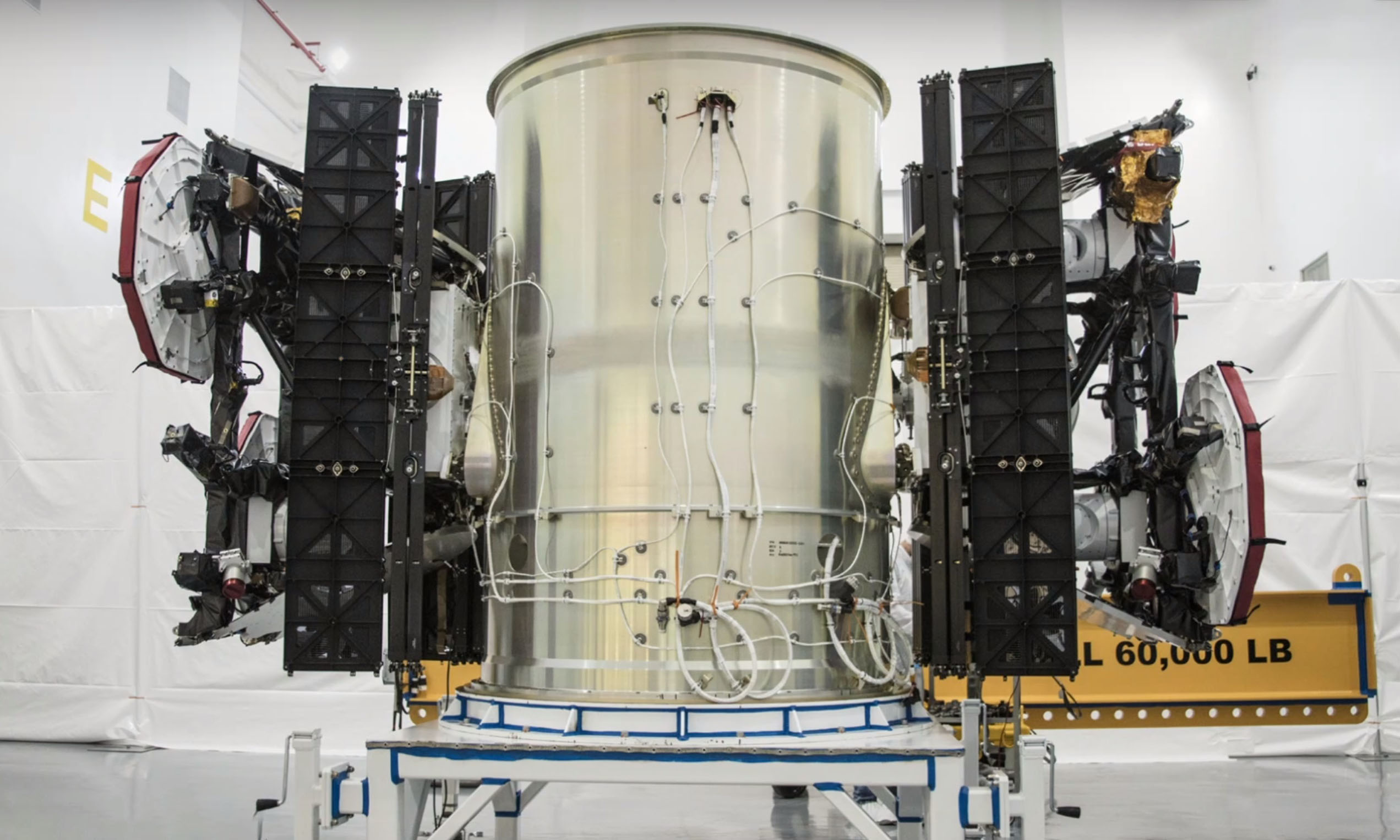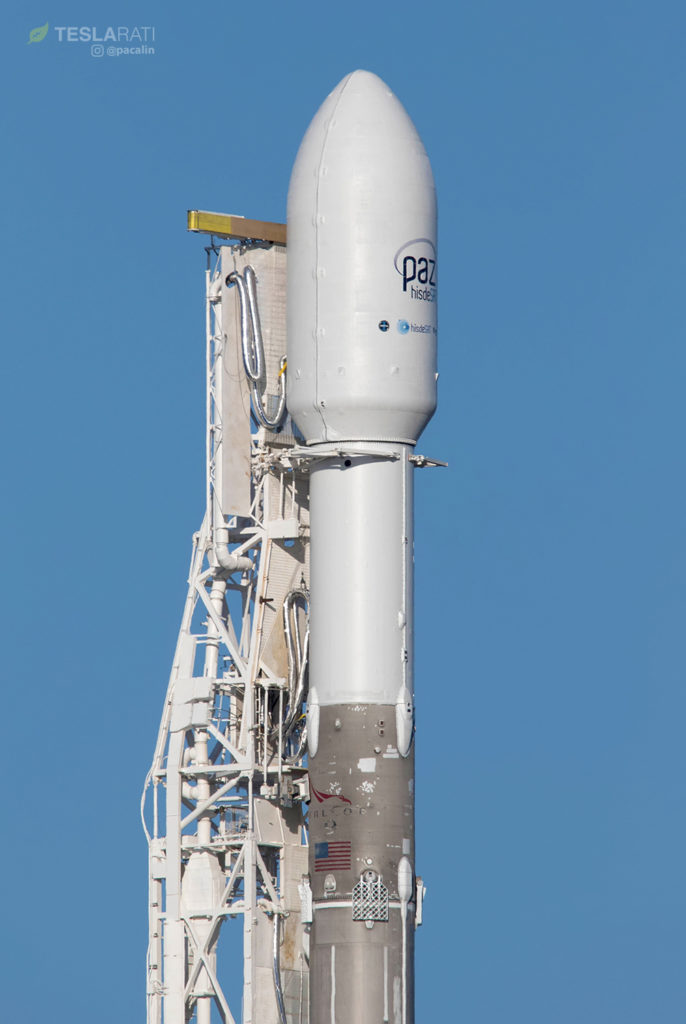

SpaceX
SpaceX Starlink becomes first US mega-constellation to gain FCC approval
Sans fanfare, the Federal Communications Commission (FCC) has made SpaceX the first US-based entity authorized to launch and operate a massive broadband internet satellite constellation in Low Earth Orbit (LEO).
The Starlink constellation authorization comes a bit less than five weeks after SpaceX launched its first two prototype communications satellites as co-passengers with the Spanish PAZ imaging satellite. CEO Elon Musk confirmed that they had safely made it to orbit and were communication with ground control in Hawthorne, CA, but SpaceX’s lips have remained sealed beyond Musk’s brief mention.
First two Starlink demo satellites, called Tintin A & B, deployed and communicating to Earth stations pic.twitter.com/TfI53wHEtz
— Elon Musk (@elonmusk) February 22, 2018
Unofficially, sources in the loop were told that Musk forwarded a memo to all hands soon after launch, confirming that the Starlink prototypes had successfully sent their “Hello, world” message to ground control. In the month since launch, the Tintin twins appear to have both raised their orbits slightly, suggesting that their propulsion systems were/are at least partially functional. Per FCC licenses for the experimental satellites, the Tintins are expected to eventually raise their orbits from 500km to approximately 1100km over the course of testing, maneuvering that would require their SpaceX-designed ion propulsion modules to function properly.
- SpaceX’s first Starlink prototypes launched in late February aboard a flight-proven Falcon 9 booster. (Pauline Acalin)
- SpaceX’s Starlink satellite constellation efforts could provide the company with valuable experience that can be applied around Mars. (unofficial logo by Eric Ralph)
Gwynne Shotwell, COO of SpaceX, gave an official statement on the FCC’s authorization of Starlink, reiterating the company’s awareness of a huge amount of work ahead of any operational constellation.
“We appreciate the FCC’s thorough review and approval of SpaceX’s constellation license. Although we still have much to do with this complex undertaking, this is an important step toward SpaceX building a next-generation satellite network that can link the globe with reliable and affordable broadband service, especially reaching those who are not yet connected.”
As the SpaceX’s first foray into true electric propulsion and dedicated communications satellites, not to mention an array of cutting-edge technologies (optical/laser-based interlinks, advanced antenna tech, and more) presumed to be on board, it’s fair to assume that the public silence is indicative of a heads-down work ethic while Starlink engineers and technicians get a handle on the tasks before them and learn volumes about the manufacture and operation of advanced satellites. If they were to occur, failures or serious problems with these first two prototypes would, in fact, benefit SpaceX and strengthen all future prototype testing efforts, ultimately resulting in a more successful final product and happier customers in the long term.

SpaceX’s first two Starlink prototype satellites are pictured here before their inaugural launch, showing off a thoroughly utilitarian bus and several advanced components. (SpaceX)
Although the FCC’s approval carries with it a number of conditional requirements of SpaceX, it is all but guaranteed that SpaceX will be able to satisfy those conditions and ensure that Starlink remains authorized, barring any significant and unforeseen legal challenges. Of those conditions, the most significant condition of note relates to a request for additional information from SpaceX on the company’s end-of-life and deorbit practices in order to guarantee that the constellation’s 4,000+ satellites do not become a space debris risk. The most serious threat to Starlink as it stands proposed today is the FCC’s decision to deny SpaceX a waiver for the requirement that 50% of any given LEO internet constellation must be launched six years after approval. In the case of the 4400+ satellite Starlink constellation, this would require SpaceX to launch more than 30 satellites a month for every month between now and March of 2024. Thankfully, the FCC approval acknowledges that it will reconsider SpaceX’s request for a waiver of this requirement in the future, once the design of Starlink has been finalized.
Correction: While the FCC’s final license grant appeared to deny a waiver requested by SpaceX for the requirement of launching 50% of the constellation within six years of licensing, the FCC has in fact already reconsidered this requirement [PDF] for uniquely large constellations out of its sheer impracticality. SpaceX should thus have some added flexibility in the pace of its deployment of Starlink.
Limited internet service from SpaceX’s Starlink constellation is not expected to begin before 2020 at the earliest. The FCC’s announcement can be read in the news release here [PDF] or in the full application approval here [PDF].
https://www.youtube.com/watch?v=v5-WCwZ4cSE
Follow us for live updates, behind-the-scenes sneak peeks, and beautiful photos from our East and West coast photographers.
Teslarati – Instagram – Twitter
Tom Cross – Twitter
Pauline Acalin – Twitter
Eric Ralph – Twitter

Elon Musk
SpaceX issues statement on Starship V3 Booster 18 anomaly
The incident unfolded during gas-system pressure testing at the company’s Massey facility in Starbase, Texas.

SpaceX has issued an initial statement about Starship Booster 18’s anomaly early Friday. The incident unfolded during gas-system pressure testing at the company’s Massey facility in Starbase, Texas.
SpaceX’s initial comment
As per SpaceX in a post on its official account on social media platform X, Booster 18 was undergoing gas system pressure tests when the anomaly happened. Despite the nature of the incident, the company emphasized that no propellant was loaded, no engines were installed, and personnel were kept at a safe distance from the booster, resulting in zero injuries.
“Booster 18 suffered an anomaly during gas system pressure testing that we were conducting in advance of structural proof testing. No propellant was on the vehicle, and engines were not yet installed. The teams need time to investigate before we are confident of the cause. No one was injured as we maintain a safe distance for personnel during this type of testing. The site remains clear and we are working plans to safely reenter the site,” SpaceX wrote in its post on X.
Incident and aftermath
Livestream footage from LabPadre showed Booster 18’s lower half crumpling around the liquid oxygen tank area at approximately 4:04 a.m. CT. Subsequent images posted by on-site observers revealed extensive deformation across the booster’s lower structure. Needless to say, spaceflight observers have noted that Booster 18 would likely be a complete loss due to its anomaly.
Booster 18 had rolled out only a day earlier and was one of the first vehicles in the Starship V3 program. The V3 series incorporates structural reinforcements and reliability upgrades intended to prepare Starship for rapid-reuse testing and eventual tower-catch operations. Elon Musk has been optimistic about Starship V3, previously noting on X that the spacecraft might be able to complete initial missions to Mars.
Elon Musk
SpaceX Starship Version 3 booster crumples in early testing
Photos of the incident’s aftermath suggest that Booster 18 will likely be retired.

SpaceX’s new Starship first-stage booster, Booster 18, suffered major damage early Friday during its first round of testing in Starbase, Texas, just one day after rolling out of the factory.
Based on videos of the incident, the lower section of the rocket booster appeared to crumple during a pressurization test. Photos of the incident’s aftermath suggest that Booster 18 will likely be retired.
Booster test failure
SpaceX began structural and propellant-system verification tests on Booster 18 Thursday night at the Massey’s Test Site, only a few miles from Starbase’s production facilities, as noted in an Ars Technica report. At 4:04 a.m. CT on Friday, a livestream from LabPadre Space captured the booster’s lower half experiencing a sudden destructive event around its liquid oxygen tank section. Post-incident images, shared on X by @StarshipGazer, showed notable deformation in the booster’s lower structure.
Neither SpaceX nor Elon Musk had commented as of Friday morning, but the vehicle’s condition suggests it is likely a complete loss. This is quite unfortunate, as Booster 18 is already part of the Starship V3 program, which includes design fixes and upgrades intended to improve reliability. While SpaceX maintains a rather rapid Starship production line in Starbase, Booster 18 was generally expected to validate the improvements implemented in the V3 program.
Tight deadlines
SpaceX needs Starship boosters and upper stages to begin demonstrating rapid reuse, tower catches, and early operational Starlink missions over the next two years. More critically, NASA’s Artemis program depends on an on-orbit refueling test in the second half of 2026, a requirement for the vehicle’s expected crewed lunar landing around 2028.
While SpaceX is known for diagnosing failures quickly and returning to testing at unmatched speed, losing the newest-generation booster at the very start of its campaign highlights the immense challenge involved in scaling Starship into a reliable, high-cadence launch system. SpaceX, however, is known for getting things done quickly, so it would not be a surprise if the company manages to figure out what happened to Booster 18 in the near future.
Elon Musk
SpaceX’s next project will produce Starships at a level that sounds impossible
1,000 rockets per year is an insane number, especially considering Starship’s sheer size.

Elon Musk has revealed bold plans for SpaceX’s newest Starbase facility in Texas, predicting it will become a birthplace for “so many spaceships.” The upcoming “Gigabay,” a massive $250 million production hub in Starbase, Texas, is designed to manufacture up to 1,000 Starship rockets per year.
That’s an insane number of rockets for a single facility, especially considering Starship’s sheer size.
One of the world’s largest industrial structures
SpaceX’s Gigabay is expected to stand roughly 380 feet tall and enclose 46.5 million cubic feet of interior space, making it one of the largest industrial structures to date. The facility will feature 24 dedicated work cells for assembling and refurbishing Starship and Super Heavy vehicles, complete with heavy-duty cranes capable of lifting up to 400 U.S. tons, as noted in a Times of India report.
Construction crews have already placed four tower cranes on-site, with completion targeted for December 2026. Once operational, the Gigabay is expected to boost SpaceX’s launch cadence dramatically, as it would be able to build up to 1,000 reusable Starships per year, as noted in a report from the Dallas Express. Musk stated that the Gigabay will be “one of the biggest structures in the world” and hinted that it represents a major leap in Starbase’s evolution from test site to full-scale production hub.
A key step toward Mars and beyond
Starship is SpaceX’s heavy-lift rocket system, and it remains a key part of Elon Musk’s vision of a multiplanetary future. The vehicle can carry 100–150 tonnes to low Earth orbit and up to 250 tonnes in expendable mode. With several successful flights to date, including a perfect 11th test flight, the Starship program continues to refine its reusable launch system ahead of crewed lunar missions under NASA’s Artemis initiative.
Starship is unlike any other spacecraft that has been produced in the past. As per Elon Musk, Starship is a “planet-colonizer” class rocket, as the magnitude of such a task “makes other space transport task trivial.” Considering Starship’s capabilities, it could indeed become the spacecraft that makes a Moon or Mars base feasible.










